This photo was taken by my father in 1951, from one of the bridges over the Thames (no idea which one), and shows one of the pleasure boats that have been a feature of London’s river for many years.
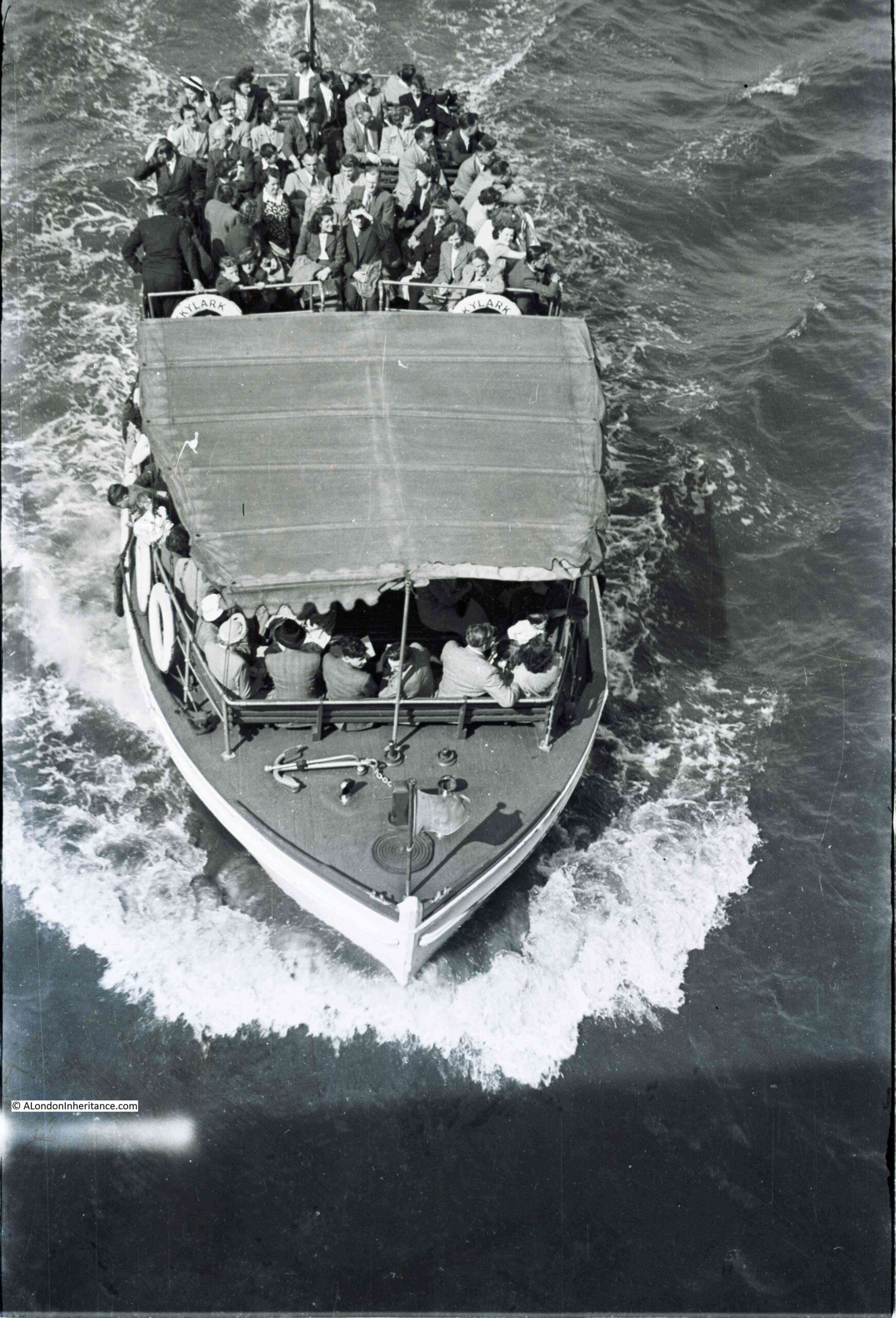
It was the only photo featuring the Thames on the strip of negatives, so I suspect he was walking over the bridge, saw the boat about to pass under the bridge, and quickly took the photo.
It is one of those photos that probably seemed of not much importance at the time. A scene that was, and continues to be, very common on the river, but 71 years later it is a snapshot of a group of people travelling along the River Thames.
The boat was called the Skylark. I cannot find any details about the boat, however the year was 1951 and I vaguely remember reading somewhere that the Skylark was one of the boats that served the Festival of Britain site on the Southbank, taking people to and from the pleasure gardens at Battersea. I have checked the indexes in my books on the Festival, but cannot find a reference to the Skylark so it may be my memory playing tricks – a lesson to keep better notes.
The following extract from the photo shows the people on the rear deck. Mainly adults, a couple of children, and all rather formerly dressed for a trip on the river:

Pleasure boats have been a feature of the Thames since the 19th century, when newspapers were full of adverts for pleasure trips on the river. The majority of these seemed to be a trip to somewhere, rather than a trip along the river with no stopping point, apart from a final return to the point of departure.
For example, in 1899, a return trip in the “magnificent new steamers Boadicea or Cleopatra” from Westminster to Gravesend to see the gardens could be had for one shilling and six pence.
The number of ships on the river did cause passengers some concern. A letter writer to the London Evening Standard complained of two steamers appearing to race each other on the river, and one almost crashing into his boat in attempt to overtake. He finishes off his letter with “I for one, will never again take a pleasure trip on the Thames”.
The river is much quieter today, but with the return of tourism to London, the pleasure boats are again filling up and can be seen taking passengers on tours up and down the river.
This was my attempt to emulate my father’s photo:

This is the view from Waterloo Bridge showing one of the mooring places for pleasure boats:
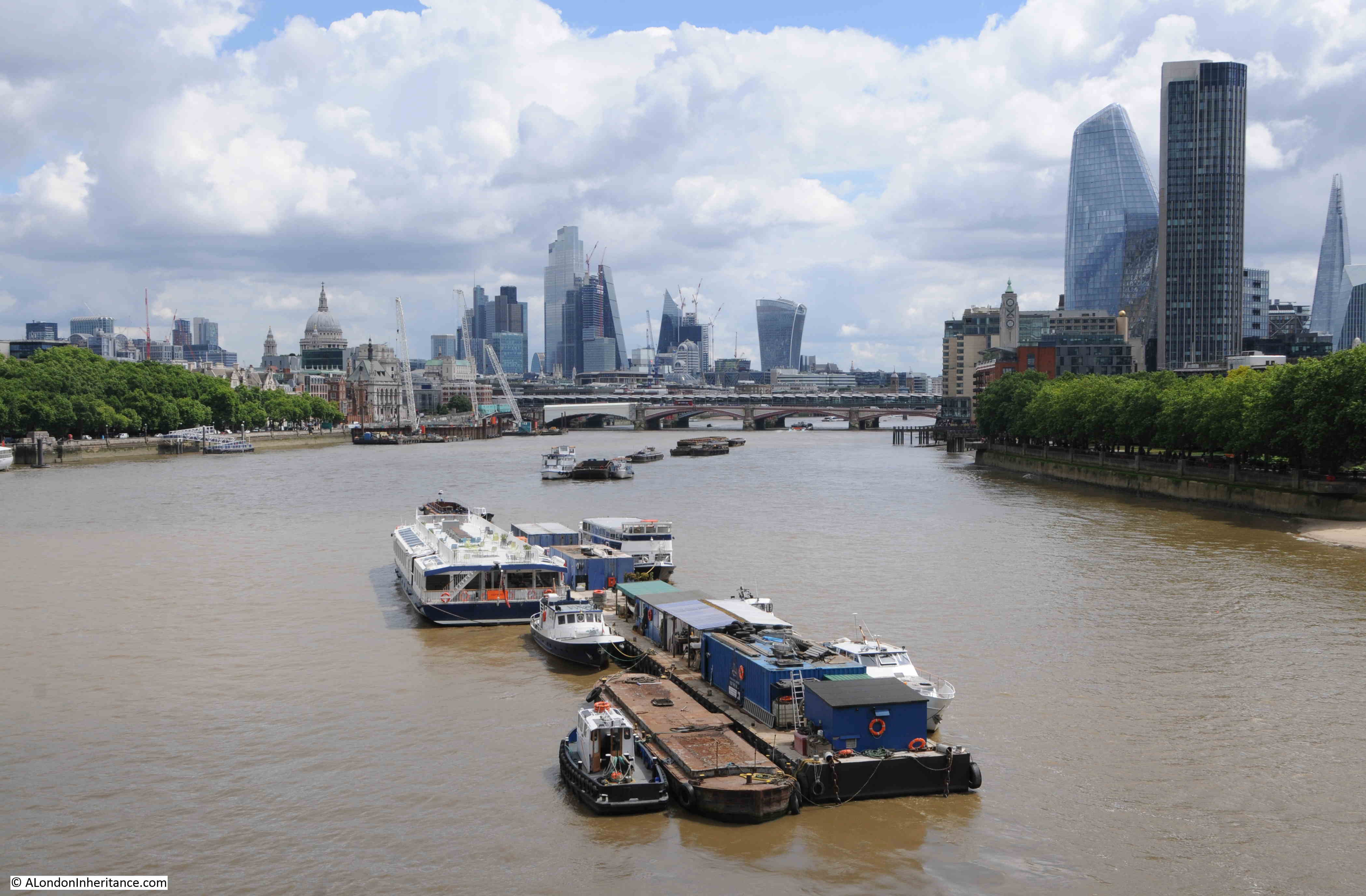
As well as general tours, you can take a Horrible Histories themed tour telling the story of the Terrible Thames:
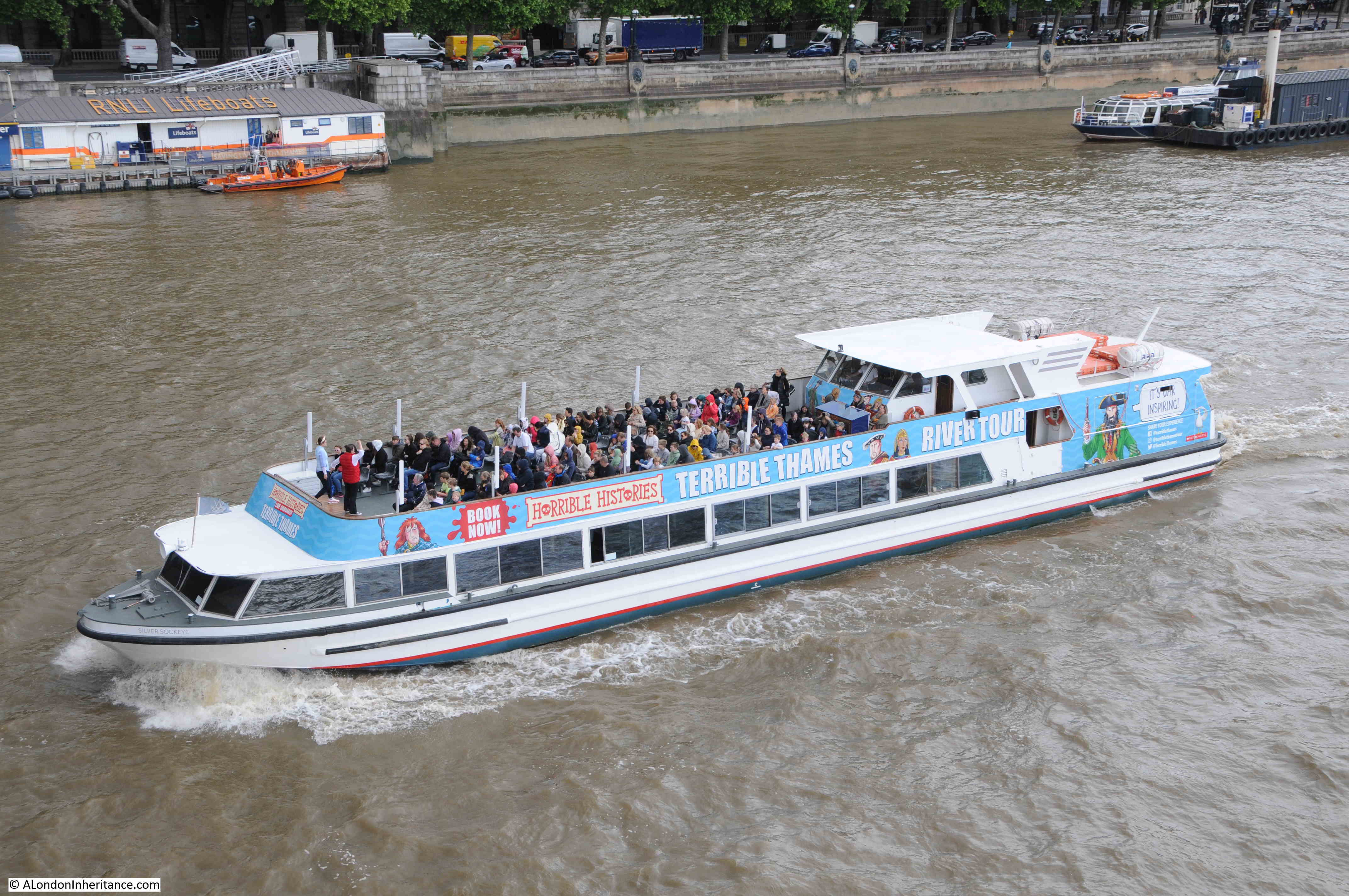
A full City Cruises boat with one of the smaller Thames Clippers on the left:
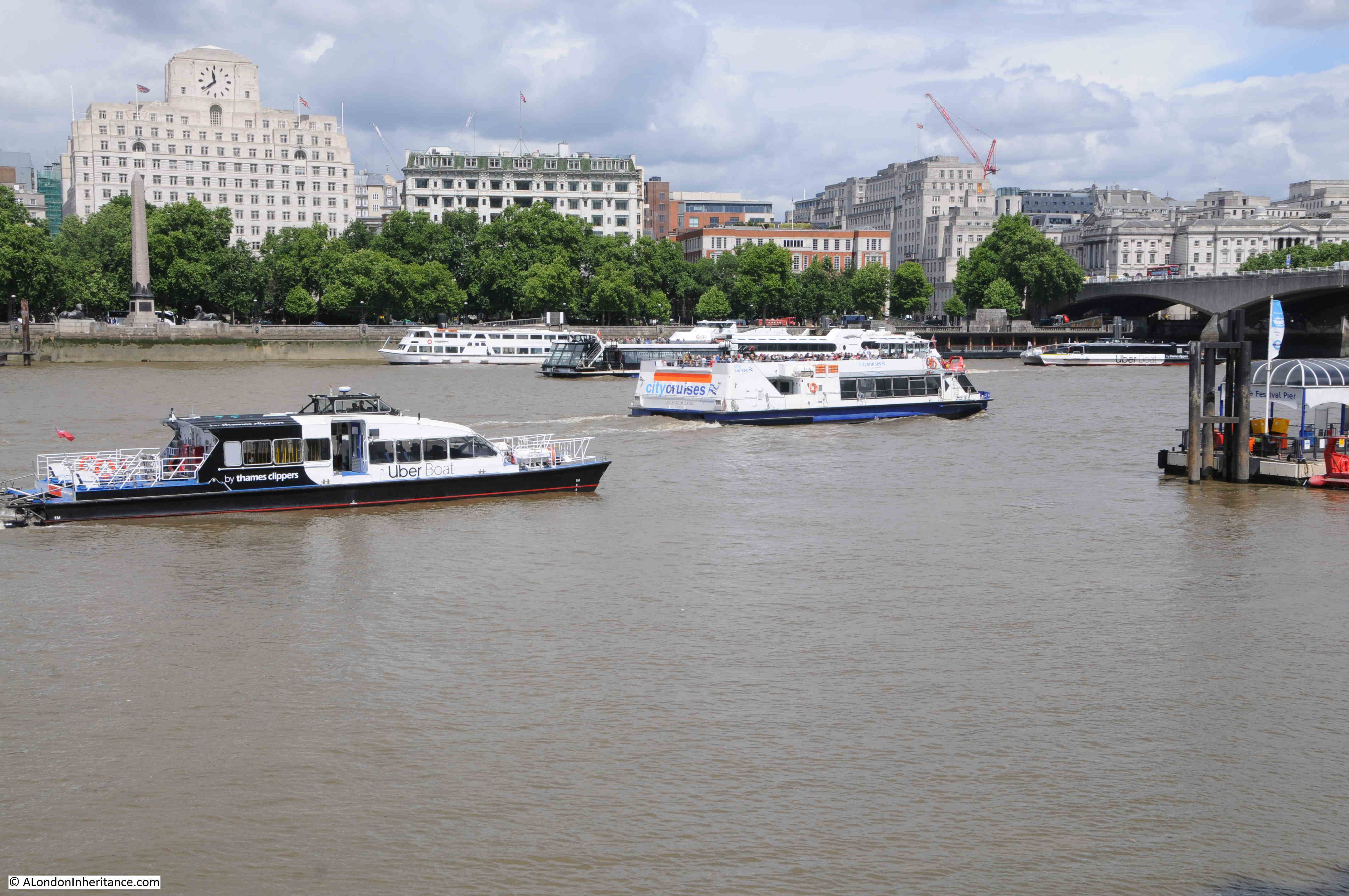
The small Thames Clipper boat seems to have a specialised role to shuttle passengers from the cruise ships that moor alongside HMS Belfast, across the river to Tower Stairs.
The Silver Barracuda, one of the Woods Silver Fleet, owned by a family who have been Thames Watermen for over 150 years:
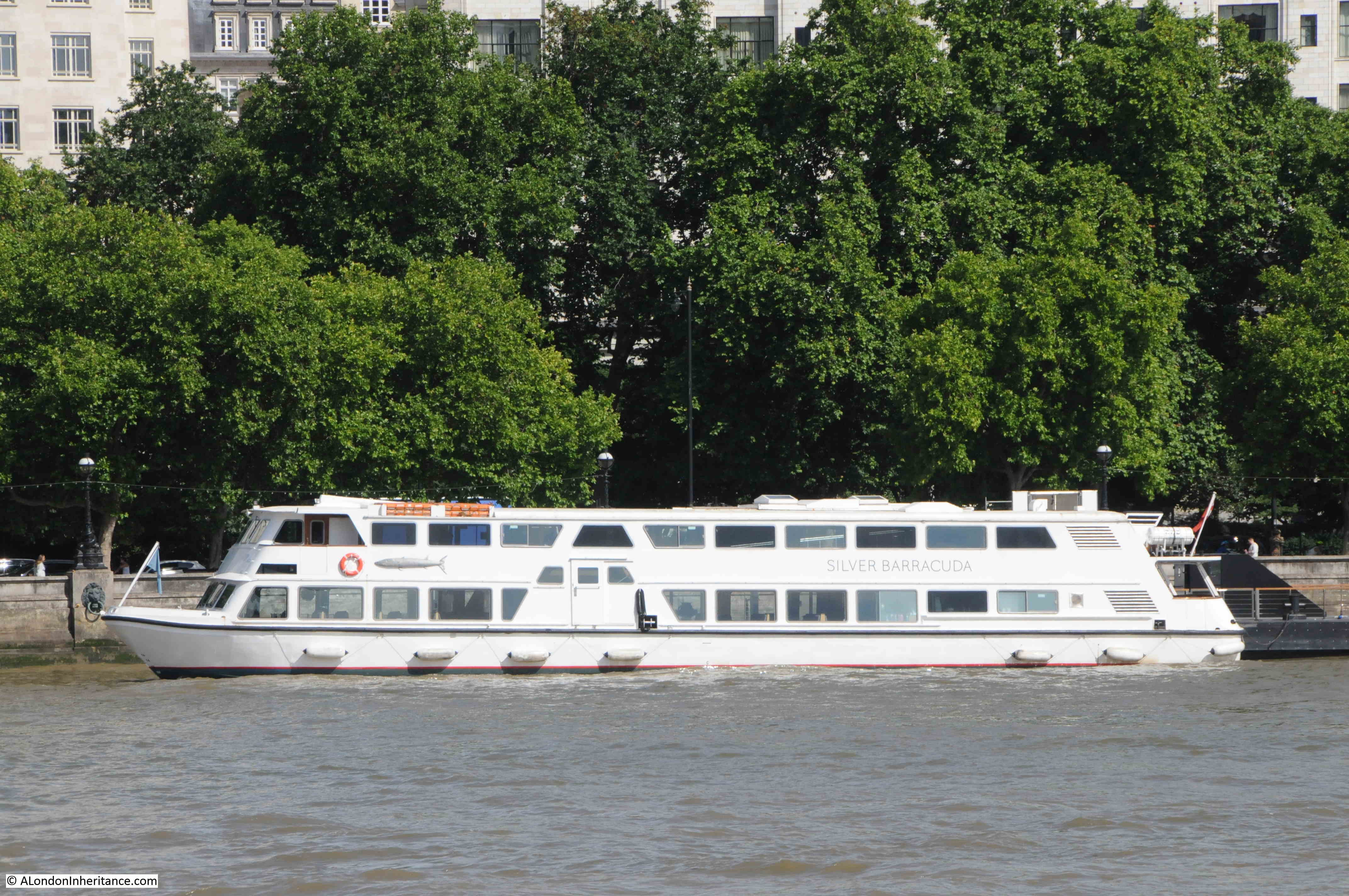
One of the dining boats that cruise up and down the river:
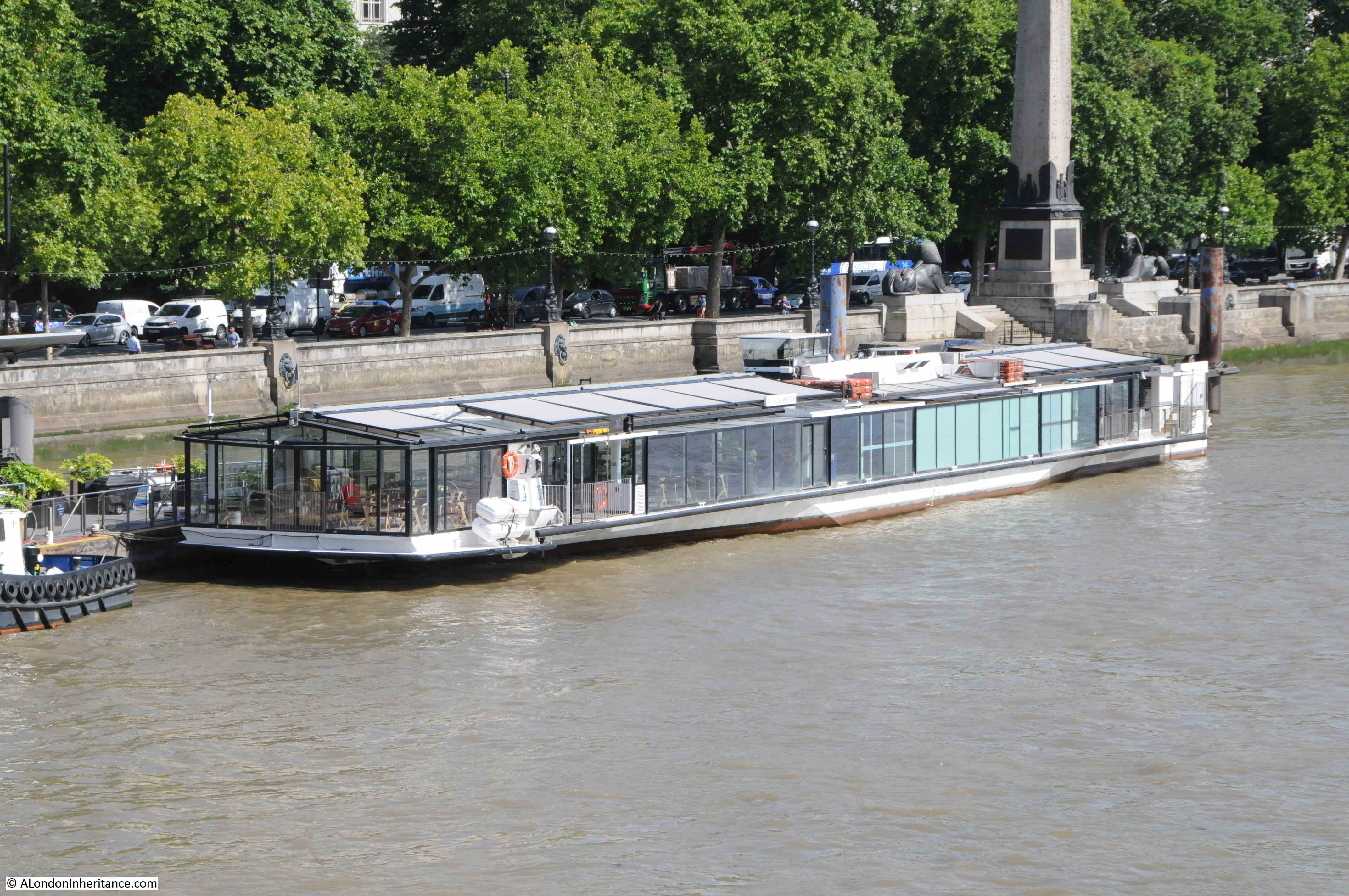
With the closure of the London docks, traffic on the river significantly declined with the late 1970s and early 1980s being a period where it was so sad to see the quiet river.
The river has though, long been a way to travel across London – a liquid Central Line.
Going back centuries, it was often the fastest and safest method of travel, with watermen being the taxis of the day, rowing passengers between the numerous Thames stairs. Although they did have frequent accidents, and negotiating a fixed price was often a challenge until the gradual regulation of watermen services on the river helped to clamp down on poor practices.
Today, the ferry services once provided by a waterman rowing you along the Thames has been replaced by the Uber Boats run by Thames Clippers:
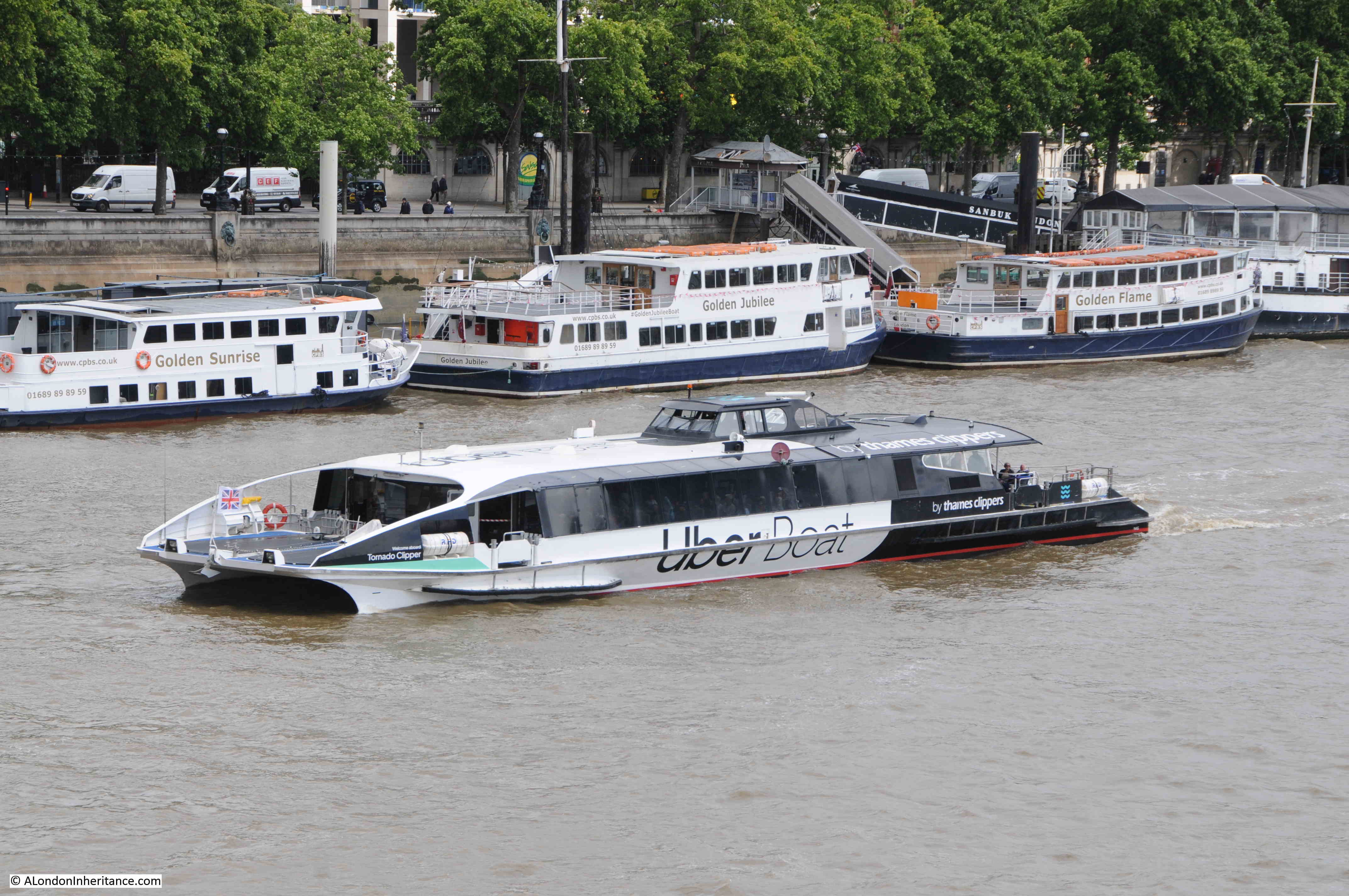
The Thames Clippers have been a 21st Century success story along the Thames. Since starting with a single boat in 1999, the company now has around 20 boats serving passengers on the Thames. The majority were made in Australia, however three, Jupiter, Mercury and Venus, were built on the Isle of Wight.
Each of the boats has their own unique flash of colour on the side of the bow (front) of the boat. In the above photo, the colour is (I think), mint, which identifies the boat as the Tornado Clipper (helpfully the name is also above the flash of colour, however the colour helps with identification at a distance).
Cyclone Clipper:
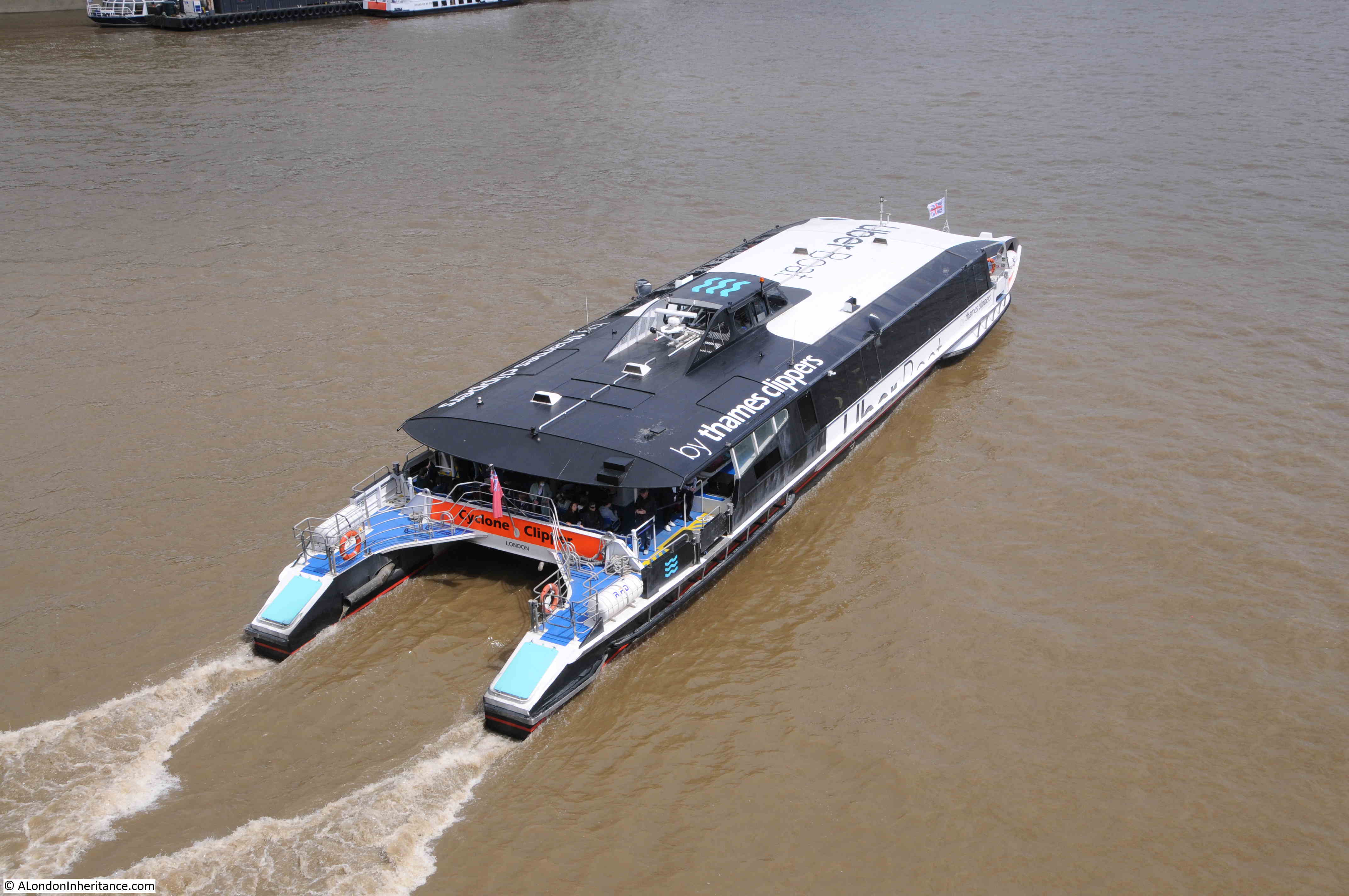
The Thames Clippers are the latest in a series of post-war attempts at running passenger services on the river. Some more successful than others.
Starting in 1905, the London County Council launched a number of steam-boat ferries along the Thames, with 30 boats at the peak of services. The following photo shows the “Opening of the L.C.C Steamboat Service by H.R.H The Prince of Wales”.

The post-war reduction in the population of east London, along with the closure of industry and docks along the river reduced the need for a ferry service, however there were a number of attempts at launching ferry services.
1968 saw a Hovercraft service along the river. The first hydrofoil, Shearwater 5 started passenger services in 1969. In 1988 Thamesline offered a service between the developing docklands and the City and a limited River Bus service was launched in 1989.
The launch of the Thames Clippers in 1999 came at a time when the redevelopment of the docklands resulted in increasing populations of residents and office workers, as well as significant increases in tourist numbers. investment by the company that owned the O2 also helped with the growth of the Thames Clipper services that we see today.
In 2019, the last year before Covid, Thames Clippers carried a total of 4.3 million passengers.
An addition to the Thames over recent years has been the ribs that offer visitors a high speed trip down the river to the east of Tower Bridge. Yellow ribs:

And red ribs, with a London Eye River cruise moored at the London Eye pier in the background:
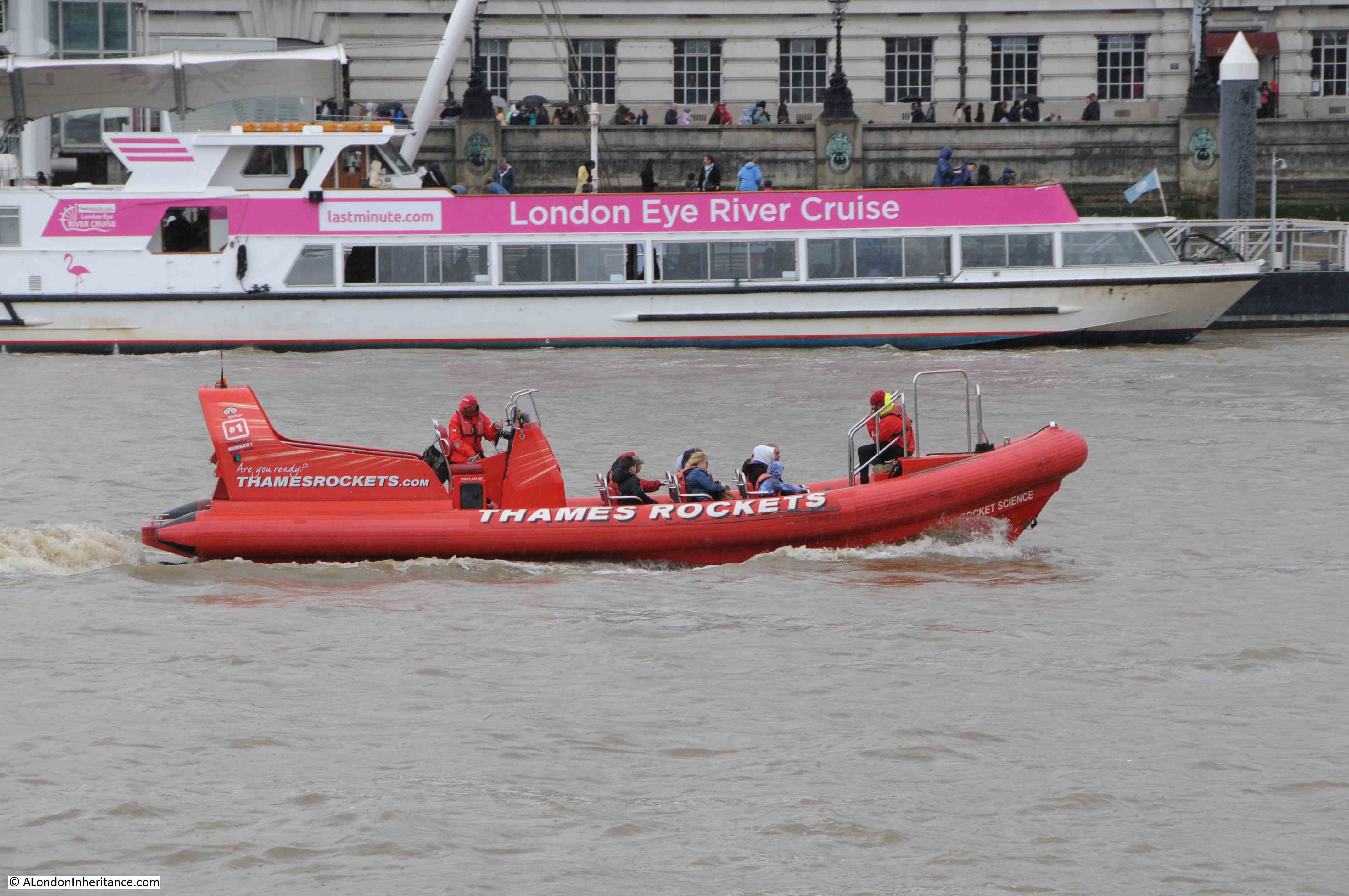
Ribs moored up at the Festival Pier on the Southbank:

As well as tourist and passenger traffic, there are many other users of the Thames.
The Thames River Police can frequently be seen speeding along the river:

And much of London’s waste is compacted into containers at depots along the river, from where it is then transferred by barge to an incinerator in Belvedere, where it is burnt to generate electricity.

Although the central Thames alongside the City will not see the cargo shipping that was a feature of this part of the river for centuries, it is good to see that the river is busier than it was in the late 1970s.
Tourist boats, work boats, and the Thames Clippers, ensure that there is much to see along the river.
One of the best Twitter accounts and blogs for monitoring the range of traffic on the Thames, is the Tidal_Thames95 Twitter account and the Tidal Thames blog, both by Patricia Stoughton.
Hopefully there will be pleasure, ferry and work boats on the River Thames for many years to come.

What were the photos either side of the pleasure boat on the strip of negatives? They might offer a clue as to which bridge it was.
Another great post today about our river.
Lovely to see the trippers on the boat in your father’s photo, all decked out in their ‘Sunday Best’. But that was how people dressed for a day out, in those days, even for a day on a beach.
I have photos of family sitting on deckchairs, dads in their (only) suit, mums in their best floral summer frock. There seemed little need then for lashings of suntan lotion as there was not much flesh on show.
Always a joy to receive your London Inheritance mail on a Sunday morning.
As a Londoner long time living abroad, I find these illuminating and fascinating as well a welcome dose of nostalgia.
Many thanks much appreciated
Tim in Sweden
Those who ply the Thames have had more say in the history of London than might be thought. The Company of Watermen and Lightermen of the River Thames is unlike other former City guilds in originating from an Act of Parliament in 1555. Unique in being so instituted and governed, it is not responsible to the City Corporation and thus has the distinction of being a Company without livery. London Bridge being the city’s only Thames crossing until the advent of Westminster Bridge in 1750, watermen with their wherries provided the taxi service of the day, they being hailed with a cry of ‘Oars!’. Hence Tudor London had about 30 landing places – ‘steps’ or ‘stairs’ giving access to the river – between the Tower and Westminster. In 1598, there were some 3,000 watermen with 2,000 boats, London’s population then being around 200,000. By 1746, there were more than 100 landing places between Chelsea and Shadwell, the city’s population approaching 750,000. That it took until 1750 for London to have a second bridge is due in part to watermen’s opposition. Sedan chairs and hackney carriages were opposed too, as was the permitting of theatres to transfer from Southwark to the City, all designed to protect the trade. Its decline was inevitable however in the face of alternatives such that by 1827 London had seven bridges and only around 66 river stairs still in use. Watermen now crew the vessels used on the rivers services and leisure cruises. A lightermen’s concern is not passengers but cargo, a lighter being a barge used to transfer it from ship to shore or for moving it within docks. Unpowered, a lighter was steered by oars, the waterman’s skill being in utilising the river’s tides and currents. The introduction beginning in the 19th century of enclosed docks and then the ISO container in the 1960s mean that few lightermen operate on the Thames today, their lighters now being towed by tugs. Originally, the Company’s hall was in Upper Thames Street but it was lost in the Great Fire of 1666, being rebuilt in 1670 and 1720. Designed by William Blackburn, its present hall at 16 St Mary-at-Hill was built in 1780 and is Grade II*-listed. It is the only surviving Georgian guildhall in London.
Another fabulous post – thank you
I regularly use the Thames Clippers to travel to work from my home in Wandsworth to the city. They are a joy – a bit slower and more expensive than the tube but you can get a coffee and always of course a seat…watching London from the river always makes you feel calm and ready to face the day!! It’s a great use of this wonderful river. It would be very rare to see a man with a tie on though today even for working in the city – and even suits are no longer the standard attire.
That was a lovely trip out! Channel 5 recently did a series featuring Tony Robinson following the various people who work at night along the Thames and there is a very good episode about the cleaning and maintenance of the clippers – worth a watch with a cup of tea. And I do recall, back in the 70s, a boat that was moored on the Embankment which was a bar, though the name escapes me. It was pleasant to stroll down and have a drink on a summer evening. It may still be operating – hope so.
There was an old paddle steamer moored at the Embankment – Tattershall Castle. But it went for a refit and came back as a mere floating hulk – the interior had been gutted out and all historic features removed like the paddle-wheels and steam engine.
Itcwas one of three old Humber ferries made redundant when they built the bridge. The other two were I think the Wingfield and Lincoln Castles.
You missed adding a photo of the London Duck Tours – killed off by the construction works around the London Eye.
I understand that a new service has started up, designed for commuters, running from Barking in Essex to central London. I’m told it runs Monday to Friday peak hours only but hourly during the day on Saturdays and Sundays. I must try it!
This is a really helpful book published by the Society of Genealogists :-
https://societyofgenealogists-shop.myshopify.com/products/my-ancestors-were-thames-watermen
Might the Skylark be this, Skylark 1X, one of the Dunkirk Little Ships:
https://skylarkix.co.uk/the-boat/timeline/
I don’t think Skylark IX was in London at this time. More likely the Skylark X, I think, which was also at Dunkirk, and which was a Thames pleasure craft all through this period.
https://riverthames.sosugary.com/thumbnails.php?search=skylark&submit=search&album=search&title=on&newer_than=&caption=on&older_than=&keywords=on&type=AND
The old pleasure – boats were so lovely, so civilized. There used to be a couple that went from Swan Lane stairs to Yarmouth and Margate. There is a great post about Swan Lane stairs on this site.
https://alondoninheritance.com/the-thames/old-swan-stairs/
Now London is threatened by a different kind of ‘pleasure boat’ – the Oceandiva, Europe’s biggest partyboat is trying to buy its way into London. It is nearly as long as a football pitch, three floors high and has vast open decks for partying and brand launches. They want to parade luxury cars up and down the Thames, among other things. It tried to get a bespoke berth at Swan Lane in 2020 but City councillors unanimously voted the projected down, mostly because of what would happen on the shore when 1500 partygoers disembarked at 1am or later.
Now the Oceandiva consortium has bought Butler’s Wharf, in front of 3000 residents, who are trying very hard to get some sense and decency into the picture.
Here are pictures of the Oceandiva on one of the few places where public comments were allowed before being shut down.
https://www.dailymail.co.uk/travel/travel_news/article-10692731/Pictured-25million-Oceandiva-London-superyacht-cruise-Thames-2022.html#comments
And here’s a website with more information, and more questions, about the Oceandiva and London here:
https://no-oceandiva.com/
The website links to a petition. Please sign!
Glad to see you’re still agitating, Michelle. You’re doing yeoman’s work!
Sending my regards to Clink,
Geraldine
Annie Green – I think the boat with a bar on the embankment was named “The Hispaniola”. I think it was also a restaurant in the evening.
My 60th birthday celebration with my family (some years ago!) was a lunch trip on one of the special dining boats. Highly recommended.
https://www.londonreconnections.com/2020/capitalist-hydrofoils-strike-back-part-2/ London-zeebrugge PO
Hydrofoil service from St Katherine’s Dock 1978 – I remember the signs to the docking pier when I worked on a building site of council flats in St Katherine’s dock at the time!
Thames Clippers have a contract to service the cruise ship visitors to London and use all vessels in the fleet (depending on location and demand) so you will see them running shuttles at the moorings in the Upper Pool and at Greenwich – they also provide a fast service from Tilbury to central London for some visiting vessels – as happened with the Virgin cruise liner visits early in the year.
One of our occasional family outings as a special treat in the 1950s was a day trip by boat from Putney Pier to Hampton Court with various stop-off places to pick up and put down passengers. I was quite young but it was a memorable experience, especially going through Teddington Lock.
Pleasure traffic on the Thames has a longer history than might be imagined. The first steam paddle steamers brought visitors to the Pool of London from ports up the East Coast such as Hull in the period before the railways were built (1830s to 1850s). The big event where the tourists flooded in by river was 1838 and the coronation of Queen Victoria.
Pedants Corner – The second bridge over the Thames was Putney Bridge (1729), not Westminster (1750). But it begs the question of the boundaries of London. But in the 18th century neither were in London – they spanned the river from Middlesex to Surrey.
Thanks for the memories ! The riverboat trips from Westminster down to Greenwich were an annual school holiday treat for me back in the mid ‘ 60s. There was always a live commentary given over a loud speaker about points of interest along the river. It didn’t vary much from year to year and I always eagerly anticipated reaching the Tower of London and hearing about Traitors Gate and how pirates and naughty men had been chained to await drowning by the Thames tide. Probably a lot of artistic license, does the tidal flow even reach the Tower?
Thanks to Roger Hoefling for his above informative,potted history of the watermen and lighter men of the Thames.
In answer to your question, the Thames is tidal as far as Teddington Weir.
Sometimes high tides overtop Teddington weir making Kingston reach marginally tidal. I recall mooring a private pleasure boat just upstream of Kingston Bridge when the mooring rings were briefly underwater because of the high tide.
I remember School trip down Thames to Grenwich by boat. We sung pop songs all the way, what a happy outing.
Singing among other songs Chantilly Lace (Big Bopper) so was late 50’s Memories are riches.
Later worked Mincing Lane so spent lunch hour eating sandwiches by the Tower. The River has always been so interesting, so much history, but left for greener pastures in Canada.
Enjoy my Sunday morning visits- Thank you.
Great post as always
So does a “pleasure boat” need to actually go anywhere?
I used to live by Albert Bridge in the 50’s, 60’s & 70’s. I remember a boat tied up to Cadogan Pier (the only boat there in those days) called the Sloop John D or B or something like. I believe it was some kind of restaurant or night club. I was too young to go but it always fascinated me as it seemed an exciting thing to party on the water!
Another fascinating post especially as my first job in 1966 was with the Marine division of the then Board of Trade. The team I worked for was responsible for issuing all uk passenger ships carrying more than 12 passengers with certificates to do so and of course individual passenger numbers for each vessel. Living by tye river in Pimlico I naturally took an interest in tye Thames vessels in particular and knew all their names after a couple if years in the job. I don’t recall one called the Skylark, although the phrase “a trip on the skylark” was used for trips on such boats in resorts across the UK. I recall that some of the larger boats being used in 1966 and for many years afterwards were built built before WW1, e.g. Abercorn, Viscountess, etc. Of course at the time there were always rogue operators and legislation on safety was strengthened at that time following two disasters the Darlwyn in Cornwall and another vessel in West Wales. The first one in particular, as it had no BOT certificate to carry passengers and from memory everyone ( around 30 people) was drowned.
So glad to see increased use of our river. London’s greatest asset, (apart from the people).
lovely to see the boat in 1951. As a child I can remember being taken from West Ferry to the Battersea pleasure garden for the Festival of Britain. River trips were a regular thing in my childhood, living as we did in Poplar. On one occasion an improptu trip to Greenwich resulted in our old dog (who was left on the jetty) jumping onto the next boat and ending up at Charing Cross where my embarrassed mother had to collect him from the River police.
We also had a very memorable trip to Southend on the Royal Sovereign, leaving from the Tower of London. My father was in a wheelchair and four burly sailors carried him aloft in it onto the boat.
Happy Memories, thank you for your post.
Bonny
Hi
Many thanks for all the articles re London really interesting and i can’t wait for the next instalment.
I have just been reading a really good book by Tom Nancollas entitled “Seashaken House” its about the history of the many rock lighthouses around the coast of the UK.
There is a whole chapter about the Blackwall lighthouse and its use from 1866 to present times. I hope that you find it as interesting as I did.
Kind regards
Another very interesting post; the Thames is an often overlooked resource.
The LCC was very enthusiastic about its ferry service, acquiring several piers, buying new boats and eliciting royal patronage. However, many people condemned it as a waste of taxpayers’ money. Indeed, a lack of customers associated with the slow speed of the large and unwieldy paddle-boats (which experienced a series of accidents), led to massive debt and the service closed down after about only two years.
Interestingly, the LCC had no personnel that could be quickly trained to take fares on the boats, so they used tram conductors.